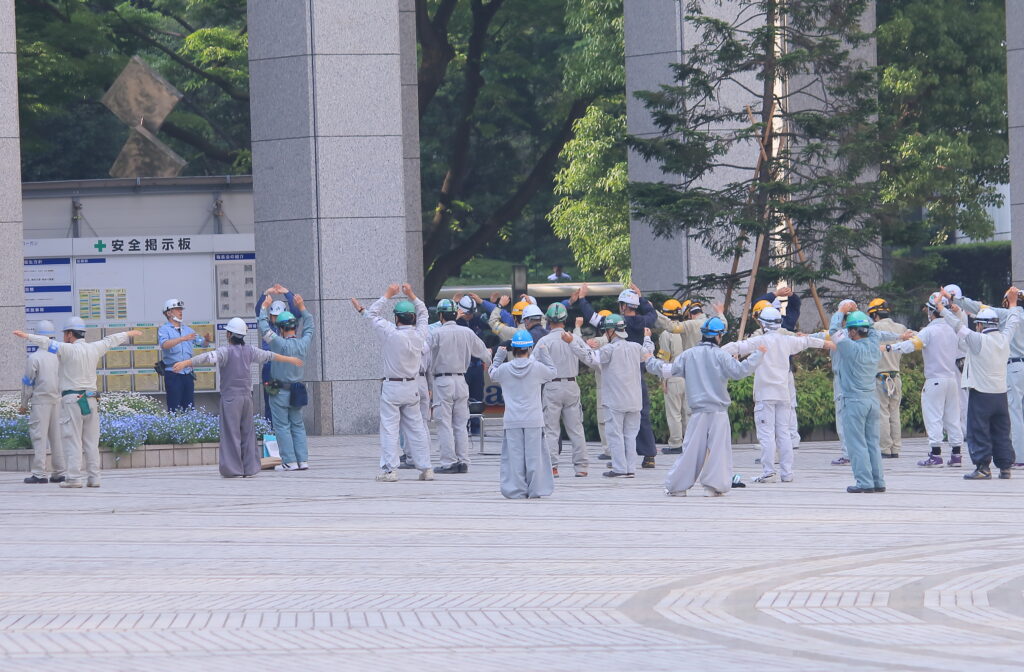ARTICLE
Warming up or stretching before starting work: Is it effective?
FOREWORD
In recent years, the number of musculoskeletal disorders (MSDs) has increased in most sectors of activity.
MSDs are therefore a priority for intervention for most organizations. As a result, companies must seek to control and limit exposure to recognized risk factors by acting on the determinants of these said factors.
Identifying and controlling the determinants of risk factors can be a worrying activity for employers with limited resources (human, financial, etc.). In this context, many employers are strongly tempted to focus their prevention efforts on an individual approach aimed at improving the worker’s capacity by encouraging the practice of physical activity in the workplace.
Warm-ups, stretching and muscle strengthening exercises are therefore of interest to many employers.
Several questions arise:
How effective are these practices?
What is the scientific validity of these practices?
For which type of workstation should workplace exercises be considered?
Etc.
Recently, the French National Research and Safety Institute (INRS) published an article reviewing the most recent scientific literature on this subject.
From the outset, a distinction must be made between stretching exercises and warm-up exercises.
Exercise that aims to raise the body temperature and the temperature of the muscles that will be used during the activity.
Exercise that aims to improve joint mobility by gradually lengthening the muscle to its maximum range.
Effectiveness of stretching exercises
In the vast majority of stretching programs observed in the workplace, static stretching exercises are offered to employees. This method consists of gradually stretching the muscle without shaking, then holding the muscle stretched for several seconds.
In short, although static stretching has long been perceived as an essential practice for optimizing physical performance, Peck et al. (2013) concluded that, following a review of the scientific literature, static stretching decreased physical performance by:
- reducing the ability and skill to generate force;
- decreasing contraction speed and agility;
- having no impact on physical endurance.
Based on these facts, at Ergokinox Inc., we believe that the practice of static stretching exercises before work activities should be avoided.
This opinion is consistent with the conclusions of several authors who conclude that the impact of stretching exercises on the prevention of MSDs has not been conclusively demonstrated:
- Choi, S.D. & Woletz, T. (2010). Do Stretching Programs Prevent Work-related Musculoskeletal Disorders? Journal of Safety, Health & Environmental Research, 6(3).
- da Costa BR, Vieira ER. (2008) Stretching to reduce work–related musculoskeletal disorders: a systematic review. J Rehabil Med. May;40(5):321-8.
- Jennifer A. Hess & Steven Hecker (2003) Stretching at Work for Injury Prevention: Issues, Evidence, and Recommendations, Applied Occupational and Environmental Hygiene, 18:5, 331-338
- Silverstein, B. & Clark, R. (2004). Interventions to reduce work-related musculoskeletal disorders. Journal of Electromyography and Kinesiology, 14(1) 135-152.
Effectiveness of warm-up exercises
On the other hand, very few scientific studies have been conducted on daily warm-ups in the workplace.
In 2003, the Health and Safety Executive concluded in its document The principles of good manual handling: Achieving a consensus that there was no scientific evidence of the beneficial effects of warm-up exercises in reducing MSDs during work activities involving the handling of loads.
Even if their effectiveness in preventing MSDs has not been proven, the results of some studies illustrate, more broadly, their beneficial effects on physical and mental preparation, the strengthening of team spirit and the opportunity offered to disseminate specific messages on occupational health and safety.
Furthermore, it is interesting to note that in a study published in 2015, Goldenhar et al. demonstrated that 28% of workers involved in a pre-activity warm-up program considered them useful for identifying painful areas and thus perhaps for avoiding more serious injury.
In short, it is important to note that these studies have not objectively demonstrated the effectiveness of warm-up exercises in preventing MSDs.

(Source : shutterstock.com)
Conclusion
Consequently, given the lack of conclusive results, at Ergokinox, we believe that the practice of preventive exercises in the workplace should be considered only as a complement to conventional preventive measures aimed at reducing the level of ergonomic risk in the work environment.
We can conclude that workplace exercise programs add measurable costs for results that have not yet been proven. On the other hand, the identification, quantification and control of MSD risk factors and their determinants are recognized as offering beneficial results in reducing MSDs.
In this context, a company with limited resources that wishes to invest in MSD prevention should focus on proven methods for identifying, measuring and controlling the risk factors for musculoskeletal injuries.
